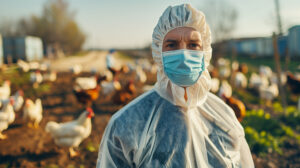Key Points:
- In today’s Recommendations for Industry, we discuss how COVID-19 has impacted other areas of public health. Read more below.
- In the U.S., new COVID-19 cases have dropped by 42%; although death rates and hospitalizations remain high (CIDRAP). However, around the world, COVID-19 still persists. In fact, in Hong Kong, daily cases have now topped 2,000 cases per day. Similarly, cases are also high in New Zealand, where, once having originally controlled the virus is now struggling with the Omicron variant (CIDRAP2).
- Ontario, Canada will end its COVID-19 vaccine passport system on March 1st; individuals will no longer require proof of vaccination (Detroit News).
- A recent JAMA study found that mixing and matching COVID-19 vaccine boosters (e.g., using a different booster than the original series) may lead to fewer infections (CIDRAP). The CDC’s recent data, which seems to echo “preliminary research from Israel and Britain” has found that “protection from booster doses declines within a few months,” “plung[ing] after four months.” However, the analysis did not include a comparison to demographic data (NYT).
- Two papers that will soon be presented “at upcoming professional society meetings suggest that some long COVID-19 symptoms may be related to the effect of SARS-CoV-2 on the vagus nerve and that the use of enhanced external counterpulsation (EECP)—which increases blood flow—can improve some of those symptoms, respectively” (CIDRAP).
Influenza:
- Around the U.S., the CDC reports that “sporadic influenza activity continues across the country”; in fact, cases are decreasing. Where there are reports, “flu deaths tend to be occurring primarily among the elderly.” The majority of U.S. influenza cases are Influenza A (H3N2).
- Around the world, “influenza activity decreased” as well.
Public Health & Food Safety:
- Due to drug cartel interference, some Mexican avocados have been banned until further notice (Food Safety News).
- H5N1 avian flu is spreading. Not only is it spreading to hit more poultry flocks in Africa (Cameroon) and Europe (Denmark and Romania) (CIDRAP), it is also expanding into poultry flocks in Kentucky and Virginia (CIDRAP2).
- Published in Infection Control & Hospital Epidemiology, a recent population-based surveillance study “conducted at five US sites found a high incidence of infections caused by extended-spectrum beta-lactamase–producing Enterobacterales (ESBL-E) […] An incident ESBL-E case was defined as an Escherichia coli, Klebsiella pneumoniae, or Klebsiella oxytoca isolate resistant to at least one extended-spectrum cephalosporin and non-resistant to carbapenems” (CIDRAP).
- COVID-19 continues to wreak havoc on the American healthcare system; however, this time there is fear that due to dramatic disruptions in cancer screenings, it is likely that we may see a wave of cancer and other chronic, life-threatening illnesses, that may begin to arise (VOX).
Recommendations for Industry
As COVID Recedes, New Challenges Arise
As COVID continues to recede across the US, some businesses are seeing new challenges with worker absence from other infectious diseases or issues occurring due to lack of public health attention during the pandemic. While we have not yet heard of any significant impact, there is evidence of non-COVID diseases reemerging:
- Influenza – Flu reports continue to be numerous, indicating that global cases continue to be reported, though some areas are beginning to see a decrease, including the U.S., where cases appear to be sporadic. Where flu deaths are reported, these tend to occur primarily among the elderly.
- Hepatitis A – According to CDC, Hepatitis outbreaks continue to occur in the U.S., with widespread person-to-person outbreaks being seen. Recent foodborne outbreaks have also occurred, traced primarily to imported food. Hepatitis A is spread when a person ingests fecal matter from contact with objects, food, or drinks contaminated by feces or stool from an infected person. It also is spread from person to person.
- Avian Influenza – H5N1 avian flu has hit poultry in Africa and Europe and is now being seen in poultry in Kentucky and Virginia. While human infection of H5N1 is not common, sporadic cases have occurred, 60% of which are fatal in people.
- Untended issues – COVID-19’s disruption to routine checkups and screenings delayed diagnoses of various cancers and other chronic, life-threatening illnesses. The blow to the preventive services that can catch potential health problems before they become life-threatening is leading to predictions that this will be the next crisis that overwhelms the US health system. Other COVID impacts – From increased traffic deaths to decreased immunities, the pandemic has impacted the public health of the world in many ways. According to a New York Times article, the U.S. “is enduring its most severe increase in traffic deaths since the 1940s.” Crashes — and deaths — began surging in the summer of 2020, due to an increase in aggressive driving, fueled by the frustration and anger of two years of isolation and disruption.
Because any, and all, of these can lead to increased worker health issues and absences, TAG recommends that businesses prepare for the potential consequences, ensuring you have an infectious disease plan in place, including strategies for worker shortages. Give TAG a call for more information or assistance.
In case you missed it
- In last Thursday’s Recommendations for Industry, we discussed the continued decline of COVID and the lessons it continues to impart for infectious disease (and “next pandemic”) control. Read more here.
- The future of the pandemic is looking clearer as we learn more about infection (NPR). New studies are providing an optimistic picture about immunity for those who have had COVID-19, finding that a symptomatic infection triggers an immune response in the general population, likely offering protection against severe disease and death for a few years. Those under age 50 and healthy who had COVID-19 have been shown to be well protected against severe disease if reinfected again in a future surge, says epidemiologist Laith Abu-Raddad, at Weill-Cornell Medical-Qatar. That’s important because eventually everyone will be infected, but if reinfections are milder, we will be able to better live with COVID. The study, published in the New England Journal of Medicine in December, tracked 1,300 reinfections among more than 350,000 people in Qatar finding that a prior infection reduced the risk of hospitalization upon reinfection by about 90% compared with in people having their first infection. The findings are consistent with data released by CDC last month in which a prior infection was shown to reduce the risk of hospitalization during the Delta surge by more than 50 times compared with in people who hadn’t had a prior infection and were not vaccinated. People who had both a prior infection and were vaccinated had the most protection. In particular, antibodies against SARS-CoV-2 persist in the blood for months, possibly years after an infection, scientists at the Fred Hutchinson Cancer Research Center and Emory University have reported. About six months after a SARS-CoV-2 infection, right around the time when the antibody level starts to stabilize, the immune system generates long-lived plasma cells that can make potent antibodies against SAR-CoV-2 for decades, possibly even a lifetime.
- Study reveals risk factors for severe COVID-19, related syndrome in kids (CIDRAP). A prospective cohort study of US children with COVID-19 reveals that certain demographic characteristics, preexisting chronic diseases, and initial vital sign and lab values may portend disease severity. Severe disease was associated with males (odds ratio [OR], 1.37), obesity (OR, 1.19) and some pediatric complex chronic condition (PCCC) subcategories. Vital signs and many lab test values from the day of admission were predictive of peak disease severity.
- CDC head says COVID-19 mask guidance stands, for now (CIDRAP). CDC is working on updating and evaluating its mask guidance, but with COVID-19 transmission and hospitalization rates still high throughout the country, the recommendation of indoor masking regardless of vaccination status remains in place.While encouraged by current trends, Director Rochelle Walensky said, “we are not there yet.” Meanwhile, Massachusetts will let the state’s school mask requirement expire on Feb 28 while New York is dropping mandates on both masks and vaccine requirements in businesses effective Friday. “Numbers are coming down, and it is time to adapt,” Governor Kathy Hochul said.
- Global COVID cases top 400 million as levels decline again (CIDRAP). Global cases declined 17% last week compared with the week before, though the world added 19 million new cases. The only part of the world where cases are still rising is the WHO’s Eastern Mediterranean region, where the biggest jumps were reported by Iran, Jordan, and the Palestinian Territory.
- Serious illness, death more common in pregnant women with COVID-19 (CIDRAP). Pregnant COVID-19 patients are about 40% more likely to develop serious complications or die than their uninfected peers, suggests a study led by University of Utah Health researchers published yesterday in JAMA.Relative to uninfected patients, those diagnosed as having COVID-19 were significantly more likely to die or become seriously ill because of high blood pressure-related pregnancy disorders, postpartum hemorrhage, or other respiratory infection (13.4% vs 9.2%; adjusted relative risk [aRR], 1.41). All five maternal deaths occurred in COVID-positive women.The retrospective cohort study examined the outcomes of 41,104 women who delivered at 17 US hospitals from Mar 1 to Dec 31, 2020, following them up to Feb 11, 2021. Among the patients, 2,352 had COVID-19 and 11,752 did not. A total of 14,471 newborns were included in the analysis; 2,297 were delivered by women who had COVID-19 while pregnant, and 12,017 were born to uninfected women. SARS-CoV-2 exposure was significantly linked to preterm birth at less than 37 weeks’ gestation (17.7% vs 14.1%; aRR, 1.15) and to admission to a neonatal ICU (22.0% vs 17.8%; aRR, 1.15).
- Johnson & Johnson halts production of single-dose COVID-19 vaccine (CBS News). Johnson & Johnson last year quietly shut down production at a plant in Leiden, Netherlands, which was the only facility where usable doses of the vaccine were manufactured, catching some of its customers off guard, including developing nations that prefer the single-dose drug. Johnson & Johnson has been using the plant to work on an experimental and potentially more profitable drug that could protect against an unrelated respiratory virus.
- Meet the scientist at the center of the COVID lab leak controversy (Technology Review) Shi Zhengli has spent years at the Wuhan Institute of Virology researching coronaviruses that live in bats. Her work, which has earned her the nickname China’s bat woman, has been at the center of controversy. Some have suggested that her bat samples could be the source of the COVID-19 virus, claiming that the virus could have hitched a ride to Wuhan by infecting one of her team members in their fieldwork collecting samples from bats. Or, some speculate, the live viruses her team cultured in the lab, including those created by genetic tinkering, could be the source of the pandemic.
- COVID-19 truck blockade in Canada shuts down Ford plant (AP News). A blockade of the bridge between Canada and Detroit by protesters demanding an end to Canada’s COVID-19 restrictions forced the shutdown Wednesday of a Ford plant and began to have broader implications for the North American auto industry. The bridge carries 25% of all trade between the two countries, and Canadian authorities expressed increasing worry about the economic effects.Prime Minister Justin Trudeau stood firm against an easing of Canada’s COVID-19 restrictions in the face of the mounting pressure by protests against the restrictions and against Trudeau himself.
Public Health / Food Safety:
- First avian flu case of 2022 strikes Indiana’s commercial turkeys again (FSN). Bird flu can strike twice. A commercial turkey flock in Dubois County, Indiana, last struck by highly pathogenic avian influenza (HPAI) in 2016, is again infected as the disease returns to America.The USDA’s Animal and Plant Health Inspection Service (APHIS) confirms the presence of highly pathogenic avian influenza (HPAI) in the flock, it is the first confirmed case of HPAI in commercial poultry in the US since 2020. Avian influenza rarely results in human illnesses, and no human cases have been detected in the US, but USDA reminds the public that proper handling and cooking of poultry and eggs to an internal temperature of 165˚F kills bacteria and viruses.
- Global flu slows from late December peak (CIDRAP). Global flu activity shows more signs of decline after peaking at the end of 2021, the World Health Organization (WHO) said in its latest global flu update, which covers roughly the middle 2 weeks of January.Globally, of positive flu samples at national labs in the middle of January, 64.6% were influenza A and 35.4% were influenza B. Of the subtyped influenza A samples, 96.8% were H3N2. Of the characterized influenza B samples, all belonged to the Victoria lineage.
- Groups urge McDonald’s to honor antibiotics commitment (CIDRAP). A coalition of food safety, animal welfare, and environmental health groups is pushing McDonald’s to honor its commitment to reducing the amount of antibiotics used in its beef.Yesterday, the groups sent a petition with more than 25,000 signatures to McDonald’s CEO Chris Kempczinski urging the company to fulfill its December 2018 pledge to measure medically important antibiotic use and establish reduction targets for beef suppliers in the countries that make up 85% of its beef supply chain by the end of 2020.The company has yet to set those reduction targets.





